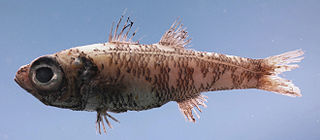
Seafood is any form of sea life regarded as food by humans, prominently including fish and shellfish. Shellfish include various species of molluscs, crustaceans, and echinoderms. Historically, marine mammals such as cetaceans as well as seals have been eaten as food, though that happens to a lesser extent in modern times. Edible sea plants such as some seaweeds and microalgae are widely eaten as sea vegetables around the world, especially in Asia.

A tuna is a saltwater fish that belongs to the tribe Thunnini, a subgrouping of the Scombridae (mackerel) family. The Thunnini comprise 15 species across five genera, the sizes of which vary greatly, ranging from the bullet tuna up to the Atlantic bluefin tuna, which averages 2 m (6.6 ft) and is believed to live up to 50 years.

Mackerel is a common name applied to a number of different species of pelagic fish, mostly from the family Scombridae. They are found in both temperate and tropical seas, mostly living along the coast or offshore in the oceanic environment.

The term carp is a generic common name for numerous species of freshwater fish from the family Cyprinidae, a very large clade of ray-finned fish mostly native to Eurasia. While carp are prized quarries and are valued as both food and ornamental fish in many parts of the Old World, they are generally considered useless trash fish and invasive pests in many parts of Africa, Australia and most of the United States.

Swordfish, also known as broadbills in some countries, are large, highly migratory predatory fish characterized by a long, flat, pointed bill. They are a popular sport fish of the billfish category, though elusive. Swordfish are elongated, round-bodied, and lose all teeth and scales by adulthood. These fish are found widely in tropical and temperate parts of the Atlantic, Pacific, and Indian Oceans, and can typically be found from near the surface to a depth of 550 m (1,800 ft), and exceptionally up to depths of 2,234 m. They commonly reach 3 m (10 ft) in length, and the maximum reported is 4.55 m in length and 650 kg (1,430 lb) in weight.

FishBase is a global species database of fish species. It is the largest and most extensively accessed online database on adult finfish on the web. Over time it has "evolved into a dynamic and versatile ecological tool" that is widely cited in scholarly publications.

Pisces (♓︎) is the twelfth and final astrological sign in the zodiac. It is a negative, mutable sign. It spans 330° to 360° of celestial longitude. Under the tropical zodiac, the sun transits this area between February 19 and March 20. In classical interpretations, the symbol of the fish is derived from the ichthyocentaurs, who aided Aphrodite when she was born from the sea.
The spiny-back eel, Notacanthus sexspinis, is a deep-sea spiny eel of the genus Notacanthus, found in all the Southern Hemisphere oceans at depths between 500 and 1,000 m. The length of this fish is up to 60 cm (24 in).

A fish is an aquatic, craniate, gill-bearing animal that lacks limbs with digits. Included in this definition are the living hagfish, lampreys, and cartilaginous and bony fish as well as various extinct related groups. Approximately 95% of living fish species are ray-finned fish, belonging to the class Actinopterygii, with around 99% of those being teleosts.
The snub-nosed spiny eel is a member of the family Notacanthidae, the deep-sea spiny eels, which are not true eels (Anguilliformes). The snub-nosed spiny eel exists in waters all over the world, except in the tropics, ranging in color from light tan to bluish grey in small ones to dark brown in large ones. Its primary food is sea anemones. The eel usually lives in deep waters, mostly more than 200 m below the surface. Female snub-nosed spiny eels reach maturity around 18 years old, and are larger than 55 cm in length at maturity. Males reach maturity around 14 years and are larger than 66 cm in length.

Epigonus is a genus of fish in the family Epigonidae found in the Atlantic, Indian and Pacific Ocean. The genus was erected by Constantine Samuel Rafinesque in 1810.
Notacanthus is a genus of spiny eels in the family Notacanthidae.
SeaLifeBase is a global online database of information about marine life. It aims to provide key information on the taxonomy, distribution and ecology of all marine species in the world apart from finfish. SeaLifeBase is in partnership with the WorldFish Center in Malaysia and the UBC Institute for the Oceans and Fisheries at the University of British Columbia. Daniel Pauly is the principal investigator and it is coordinated by Maria Lourdes D. Palomares. As of March 2023, it included descriptions of 85,000 species, 59,400 common names, 15,500 pictures, and references to 39,300 works in the scientific literature. SeaLifeBase complements FishBase, which provides parallel information for finfish.

Fins are distinctive anatomical features composed of bony spines or rays protruding from the body of Actinopterygii, Dipnomorpha, Actinistia and Chondrichthyes fishes. They are covered with skin and joined together either in a webbed fashion, as seen in most bony fish, or similar to a flipper, as seen in sharks. Apart from the tail or caudal fin, fish fins have no direct connection with the spine and are supported only by muscles. Their principal function is to help the fish swim.

Acanthostracion is a genus of boxfishes native to the Atlantic Ocean.

Gobioninae is a monophyletic subfamily of Eurasian cyprinid fishes. A species-rich subfamily, it is divided into five tribes: Gobionini, Pseudogobionini, Hemibarbini, Coreiini, and Sarcocheilichthyini.
The shortfin spiny eel, also called Bonaparte's spiny eel, is a member of the family Notacanthidae, the deep-sea spiny eels, which are not true eels (Anguilliformes).
The island cowfish is a species of ray-finned fish within the family Ostraciidae. The species occurs in the eastern Atlantic near Azores, Saint Helena and Ascension Island, Ghana, and Angola, with some individuals reported from Sao Tome Island. It lives in shallow waters 3-25 meters below the ocean surface over rocks, rubble, sand, and on shallow reef substrate near islands. It grows to a length of 50 centimeters.











